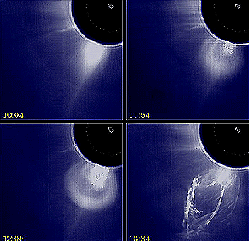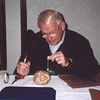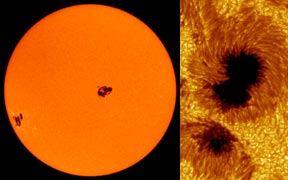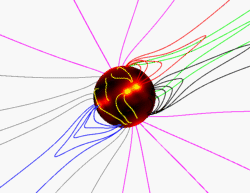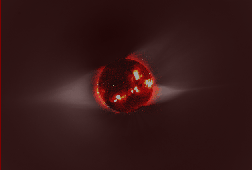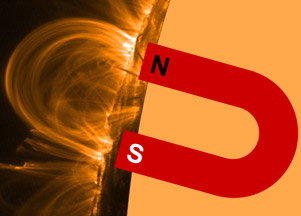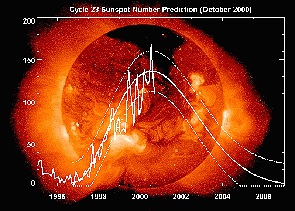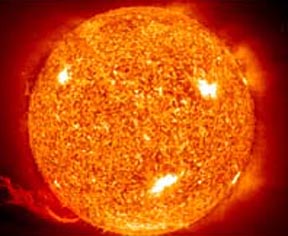Click on image for full size
Image courtesy of the High Altitude Observatory, National Center for Atmospheric Research (NCAR), Boulder, Colorado.
Related links:
Movie: Journey Beneath a Sunspot
Movie: Magnetic Field Lines Tangle as Sun Rotates
Solar Cycle Variations and Effect on Earth's Climate
Sun's Effect on Earth's Weather
Movie: Dark Days Ahead for the Sun (RealVideo courtesy of the National Science Foundation)
A movie of a prominence eruption in H-alpha, courtesy of the High Altitude Observatory (169K MPEG)
10/24/07 Solar Telescope Reaches 120,000 Feet on Jumbo-Jet-Sized Balloon
Solar Activity
The Sun is not a quiet place, but one that exhibits sudden releases of energy. One of the most frequently observed events are solar flares: sudden, localized, transient increases in brightness that occur in active regions near sunspots. They are usually most easily seen in H-alpha and X-rays, but may have effects in the entire elecromagnetic spectrum. The X-ray brightness from a large flare often exceeds the X-ray output from the rest of the Sun. Another type of event, the coronal mass ejection, typically disrupt helmet streamers in the solar corona. As much as 1e13 (10,000,000,000,000) kilograms of material can be ejected into the solar wind. Coronal mass ejections propagate out in the solar wind, where they may encounter the Earth and influence geomagnetic activity. Coronal mass ejections are often (but not always) accompanied by prominence eruptions, where the cool, dense prominence material also erupts outward.
All of these forms of solar activity are believed to be driven by
energy release from the solar magnetic field. How this energy release
occurs, and the relationship between different types of solar activity,
is one of the many puzzles facing solar physicists today.
The amount of solar activity on the Sun is not constant, and is closely
related to the typical number of sunspots that are visible.
The number of sunspots and the levels of solar
activity vary with an 11 year period known as the
solar cycle.


